No. 16. Shrub-steppe
Rex. C. Crawford and Jimmy Kagan
Geographic Distribution. Shrub-steppe habitats are common across the
Columbia Plateau of Washington, Oregon, Idaho, and adjacent Wyoming, Utah, and
Nevada. It extends up into the cold, dry environments of surrounding mountains.
Basin big sagebrush shrub-steppe occurs along stream channels, in valley bottoms
and flats throughout eastern Oregon and Washington. Wyoming sagebrush
shrub-steppe is the most widespread habitat in eastern Oregon and Washington,
occurring throughout the Columbia Plateau and the northern Great Basin. Mountain
big sagebrush shrub-steppe habitat occurs throughout the mountains of the eastern
Oregon and Washington. Bitterbrush shrub-steppe habitat appears primarily along
the eastern slope of the Cascades, from north-central Washington to California
and occasionally in the Blue Mountains. Three-tip sagebrush shrub-steppe occurs
mostly along the northern and western Columbia Basin in Washington and
occasionally appears in the lower valleys of the Blue Mountains and in the
Owyhee Upland ecoregions of Oregon. Interior shrub dunes and sandy steppe and
shrub-steppe habitat is concentrated at low elevations near the Columbia River
and in isolated pockets in the Northern Basin and Range and Owyhee Uplands.
Bolander silver sagebrush shrub-steppe is common in southeastern Oregon. Mountain
silver sagebrush is more prevalent in the Oregon East Cascades and in montane
meadows in the southern Ochoco and Blue Mountains.
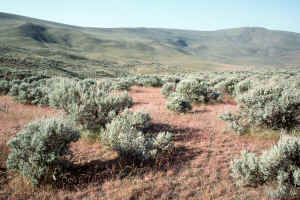 Physical Setting. Generally, this habitat is associated with dry, hot
environments in the Pacific Northwest although variants are in cool, moist areas
with some snow accumulation in climatically dry mountains. Elevation range is
wide (300-9,000 ft [91-2,743 m]) with most habitat occurring between 2,000 and
6,000 ft (610-1,830 m). Habitat occurs on deep alluvial, loess, silty or sandy-silty
soils, stony flats, ridges, mountain slopes, and slopes of lake beds with ash or
pumice soils. Physical Setting. Generally, this habitat is associated with dry, hot
environments in the Pacific Northwest although variants are in cool, moist areas
with some snow accumulation in climatically dry mountains. Elevation range is
wide (300-9,000 ft [91-2,743 m]) with most habitat occurring between 2,000 and
6,000 ft (610-1,830 m). Habitat occurs on deep alluvial, loess, silty or sandy-silty
soils, stony flats, ridges, mountain slopes, and slopes of lake beds with ash or
pumice soils.
Landscape Setting. Shrub-steppe habitat defines a biogeographic region and
is the major vegetation on average sites in the Columbia Plateau, usually below
Ponderosa Pine Forest and Woodlands, and Western Juniper and Mountain
Mahogany Woodlands habitats. It forms mosaic landscapes with these woodland
habitats and Eastside Grasslands, Dwarf Shrub-steppe, and Desert Playa and
Salt Scrub habitats. Mountain sagebrush shrub-steppe occurs at high elevations
occasionally within the dry Eastside Mixed Conifer Forest and Montane Mixed
Conifer Forest
habitats. Shrub-steppe habitat can appear in large landscape patches. Livestock
grazing is the primary land use in the shrub-steppe although much has been
converted to irrigation or dry land agriculture. Large areas occur in military
training areas and wildlife refuges.
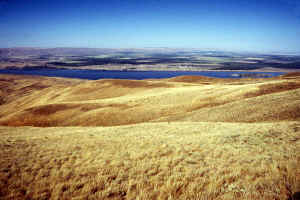 Structure.
This habitat is a shrub savanna or shrubland with
shrub coverage of 10-60%. In an undisturbed condition, shrub cover varies
between 10 and 30%. Shrubs are generally evergreen although deciduous shrubs are
prominent in many habitats. Shrub height typically is medium-tall (1.6-3.3 ft
[0.5-1.0 m]) although some sites support shrubs approaching 9 ft (2.7 m) tall.
Vegetation structure in this habitat is characteristically an open shrub layer
over a moderately open to closed bunchgrass layer. The more northern or
productive sites generally have a denser grass layer and sparser shrub layer
than southern or more xeric sites. In fact, the rare good-condition site is
better characterized as grassland with shrubs than a shrubland. The bunchgrass
layer may contain a variety of forbs. Good-condition habitat has very little
exposed bare ground, and has mosses and lichens carpeting the area between taller
plants. However, heavily grazed sites have dense shrubs making up >40% cover,
with introduced annual grasses and little or no moss or lichen cover. Moist
sites may support tall bunchgrasses (>3.3 ft [1 m]) or rhizomatous grasses.
More southern shrub-steppe may have native low shrubs dominating with
bunchgrasses. Structure.
This habitat is a shrub savanna or shrubland with
shrub coverage of 10-60%. In an undisturbed condition, shrub cover varies
between 10 and 30%. Shrubs are generally evergreen although deciduous shrubs are
prominent in many habitats. Shrub height typically is medium-tall (1.6-3.3 ft
[0.5-1.0 m]) although some sites support shrubs approaching 9 ft (2.7 m) tall.
Vegetation structure in this habitat is characteristically an open shrub layer
over a moderately open to closed bunchgrass layer. The more northern or
productive sites generally have a denser grass layer and sparser shrub layer
than southern or more xeric sites. In fact, the rare good-condition site is
better characterized as grassland with shrubs than a shrubland. The bunchgrass
layer may contain a variety of forbs. Good-condition habitat has very little
exposed bare ground, and has mosses and lichens carpeting the area between taller
plants. However, heavily grazed sites have dense shrubs making up >40% cover,
with introduced annual grasses and little or no moss or lichen cover. Moist
sites may support tall bunchgrasses (>3.3 ft [1 m]) or rhizomatous grasses.
More southern shrub-steppe may have native low shrubs dominating with
bunchgrasses.
Composition. Characteristic and dominant mid-tall shrubs in the
shrub-steppe habitat include all 3 subspecies of big sagebrush, basin (Artemisia
tridentata ssp. tridentata), Wyoming (A. t. ssp. wyomingensis)
or mountain (A. t. ssp. vaseyana), antelope bitterbrush (Purshia
tridentata), and 2 shorter sagebrushes, silver (A. cana) and
three-tip (A. tripartita). Each of these species can be the only shrub or
appear in complex seral conditions with other shrubs. Common shrub complexes are
bitterbrush and Wyoming big sagebrush, bitterbrush and three-tip sagebrush,
Wyoming big sagebrush and three-tip sagebrush, and mountain big sagebrush and
silver sagebrush. Wyoming and mountain big sagebrush can codominate areas with
tobacco brush (Ceanothus velutinus). Rabbitbrush (Chrysothamnus
viscidiflorus) and short-spine horsebrush (Tetradymia spinosa)
are common associates and often dominate sites after disturbance. Big sagebrush
occurs with the shorter stiff sagebrush (A. rigida) or low sagebrush (A.
arbuscula) on shallow soils or high elevation sites. Many sandy areas are
shrub-free or are open to patchy shrublands of bitterbrush and/or rabbitbrush.
Silver sagebrush is the dominant and characteristic shrub along the edges of
stream courses, moist meadows, and ponds. Silver sagebrush and rabbitbrush are
associates in disturbed areas.
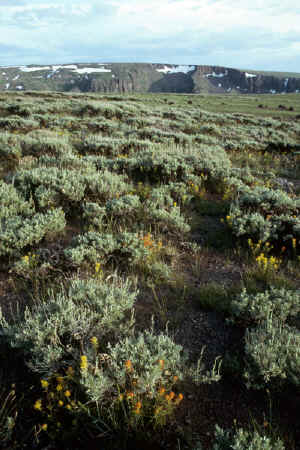 When this habitat is in good or better ecological condition a bunchgrass
steppe layer is characteristic. Diagnostic native bunchgrasses that often
dominate different shrub-steppe habitats are (1) mid-grasses: bluebunch
wheatgrass (Pseudoroegneria spicata), Idaho fescue (Festuca idahoensis),
bottlebrush squirreltail (Elymus elymoides), and Thurber needlegrass (Stipa
thurberiana); (2) short grasses: threadleaf sedge (Carex filifolia)
and Sandberg bluegrass (Poa sandbergii); and (3) the tall grass, basin
wildrye (Leymus cinereus). Idaho fescue is characteristic of the most
productive shrub-steppe vegetation. Bluebunch wheatgrass is codominant at xeric
locations, whereas western needlegrass (Stipa occidentalis), long-stolon (Carex
inops) or Geyer’s sedge (C. geyeri) increase in abundance in higher
elevation shrubsteppe habitats. Needle-and-thread (Stipa comata) is the
characteristic native bunchgrass on stabilized sandy soils. Indian ricegrass (Oryzopsis
hymenoides) characterizes dunes. Grass layers on montane sites contain
slender wheatgrass (Elymus trachycaulus), mountain fescue (F.
brachyphylla), green fescue (F. viridula), Geyer’s sedge, or tall
bluegrasses (Poa spp.). Bottlebrush squirreltail can be locally important
in the Columbia Basin, sand dropseed (Sporobolus cryptandrus) is
important in the Basin and Range and basin wildrye is common in the more
alkaline areas. Nevada bluegrass (Poa secunda), Richardson muhly (Muhlenbergia
richardsonis), or alkali grass (Puccinella spp.) can dominate silver
sagebrush flats. Many sites support non-native plants, primarily cheatgrass (Bromus
tectorum) or crested wheatgrass (Agropyron cristatum) with or without
native grasses. Shrub-steppe habitat, depending on site potential and disturbance
history, can be rich in forbs or have little forb cover. Trees may be present in
some shrub-steppe habitats, usually as isolated individuals from adjacent forest
or woodland habitats. When this habitat is in good or better ecological condition a bunchgrass
steppe layer is characteristic. Diagnostic native bunchgrasses that often
dominate different shrub-steppe habitats are (1) mid-grasses: bluebunch
wheatgrass (Pseudoroegneria spicata), Idaho fescue (Festuca idahoensis),
bottlebrush squirreltail (Elymus elymoides), and Thurber needlegrass (Stipa
thurberiana); (2) short grasses: threadleaf sedge (Carex filifolia)
and Sandberg bluegrass (Poa sandbergii); and (3) the tall grass, basin
wildrye (Leymus cinereus). Idaho fescue is characteristic of the most
productive shrub-steppe vegetation. Bluebunch wheatgrass is codominant at xeric
locations, whereas western needlegrass (Stipa occidentalis), long-stolon (Carex
inops) or Geyer’s sedge (C. geyeri) increase in abundance in higher
elevation shrubsteppe habitats. Needle-and-thread (Stipa comata) is the
characteristic native bunchgrass on stabilized sandy soils. Indian ricegrass (Oryzopsis
hymenoides) characterizes dunes. Grass layers on montane sites contain
slender wheatgrass (Elymus trachycaulus), mountain fescue (F.
brachyphylla), green fescue (F. viridula), Geyer’s sedge, or tall
bluegrasses (Poa spp.). Bottlebrush squirreltail can be locally important
in the Columbia Basin, sand dropseed (Sporobolus cryptandrus) is
important in the Basin and Range and basin wildrye is common in the more
alkaline areas. Nevada bluegrass (Poa secunda), Richardson muhly (Muhlenbergia
richardsonis), or alkali grass (Puccinella spp.) can dominate silver
sagebrush flats. Many sites support non-native plants, primarily cheatgrass (Bromus
tectorum) or crested wheatgrass (Agropyron cristatum) with or without
native grasses. Shrub-steppe habitat, depending on site potential and disturbance
history, can be rich in forbs or have little forb cover. Trees may be present in
some shrub-steppe habitats, usually as isolated individuals from adjacent forest
or woodland habitats.
Other Classifications and Key References. This habitat is called
Sagebrush steppe and Great Basin sagebrush by Kuchler 136. The Oregon
Gap II Project 126 and Oregon Vegetation Landscape-Level Cover Types
127 that would represent this type are big sagebrush shrubland, sagebrush
steppe, and bitterbrush-big sagebrush shrubland. Franklin and Dyrness 88
discussed this habitat in shrub-steppe zones of Washington and Oregon. Other
references describe this habitat 60, 116, 122, 123, 212, 224, 225.
Natural Disturbance Regime. Barrett et al. 22 concluded that
the fire-return interval for this habitat is 25 years. The native shrub-steppe
habitat apparently lacked extensive herds of large grazing and browsing animals
until the late 1800's. Burrowing animals and their predators likely played
important roles in creating small-scale patch patterns.
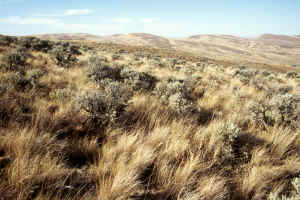 Succession and Stand Dynamics. With disturbance, mature stands of big
sagebrush are reinvaded through soil-stored or windborne seeds. Invasion can be
slow because sagebrush is not disseminated over long distances. Site dominance
by big sagebrush usually takes a decade or more depending on fire severity and
season, seed rain, postfire moisture, and plant competition. Three-tip sagebrush
is a climax species that reestablishes (from seeds or commonly from sprouts)
within 5-10 years following a disturbance. Certain disturbance regimes promote
three-tip sagebrush and it can out-compete herbaceous species. Bitterbrush is a
climax species that plays a seral role colonizing by seed onto rocky and/or
pumice soils. Bitterbrush may be declining and may be replaced by woodlands in
the absence of fire. Silver sagebrush is a climax species that establishes
during early seral stages and coexists with later arriving species. Big
sagebrush, rabbitbrush, and short-spine horsebrush invade and can form dense
stands after fire or livestock grazing. Frequent or high-intensity fire can
create a patchy shrub cover or can eliminate shrub cover and create Eastside
Grasslands habitat. Succession and Stand Dynamics. With disturbance, mature stands of big
sagebrush are reinvaded through soil-stored or windborne seeds. Invasion can be
slow because sagebrush is not disseminated over long distances. Site dominance
by big sagebrush usually takes a decade or more depending on fire severity and
season, seed rain, postfire moisture, and plant competition. Three-tip sagebrush
is a climax species that reestablishes (from seeds or commonly from sprouts)
within 5-10 years following a disturbance. Certain disturbance regimes promote
three-tip sagebrush and it can out-compete herbaceous species. Bitterbrush is a
climax species that plays a seral role colonizing by seed onto rocky and/or
pumice soils. Bitterbrush may be declining and may be replaced by woodlands in
the absence of fire. Silver sagebrush is a climax species that establishes
during early seral stages and coexists with later arriving species. Big
sagebrush, rabbitbrush, and short-spine horsebrush invade and can form dense
stands after fire or livestock grazing. Frequent or high-intensity fire can
create a patchy shrub cover or can eliminate shrub cover and create Eastside
Grasslands habitat.
Effects of Management and Anthropogenic Impacts. Shrub density and annual
cover increase, whereas bunchgrass density decreases with livestock use.
Repeated or intense disturbance, particularly on drier sites, leads to
cheatgrass dominance and replacement of native bunchgrasses. Dry and sandy soils
are sensitive to grazing, with needle-and-thread replaced by cheatgrass at most
sites. These disturbed sites can be converted to modified grasslands in the Agriculture habitat.
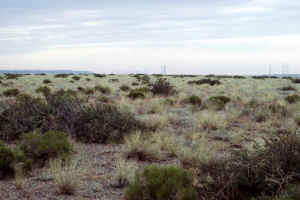 Status and Trends. Shrub-steppe habitat still dominates most of
southeastern Oregon although half of its original distribution in the Columbia
Basin has been converted to agriculture. Alteration of fire regimes,
fragmentation, livestock grazing, and the addition of >800 exotic plant
species have changed the character of shrub-steppe habitat. Quigley and Arbelbide
181 concluded that Big Sagebrush and Mountain Sagebrush cover types
are significantly smaller in area than before 1900, and that Bitterbrush/Bluebunch
Wheatgrass cover type is similar to the pre-1900 extent. They concluded that
Basin Big Sagebrush and Big sagebrush-Warm potential vegetation type’s
successional pathways are altered, that some pathways of Antelope Bitterbrush
are altered and that most pathways for Big Sagebrush-Cool are unaltered. Overall
this habitat has seen an increase in exotic plant importance and a decrease in
native bunchgrasses. More than half of the Pacific Northwest shrub-steppe habitat
community types listed in the National Vegetation Classification are considered
imperiled or critically imperiled 10. Status and Trends. Shrub-steppe habitat still dominates most of
southeastern Oregon although half of its original distribution in the Columbia
Basin has been converted to agriculture. Alteration of fire regimes,
fragmentation, livestock grazing, and the addition of >800 exotic plant
species have changed the character of shrub-steppe habitat. Quigley and Arbelbide
181 concluded that Big Sagebrush and Mountain Sagebrush cover types
are significantly smaller in area than before 1900, and that Bitterbrush/Bluebunch
Wheatgrass cover type is similar to the pre-1900 extent. They concluded that
Basin Big Sagebrush and Big sagebrush-Warm potential vegetation type’s
successional pathways are altered, that some pathways of Antelope Bitterbrush
are altered and that most pathways for Big Sagebrush-Cool are unaltered. Overall
this habitat has seen an increase in exotic plant importance and a decrease in
native bunchgrasses. More than half of the Pacific Northwest shrub-steppe habitat
community types listed in the National Vegetation Classification are considered
imperiled or critically imperiled 10.
[ Top ]
[ Literature Citations ]
[ Wildlife-Habitat Types - Table 1 ]
|